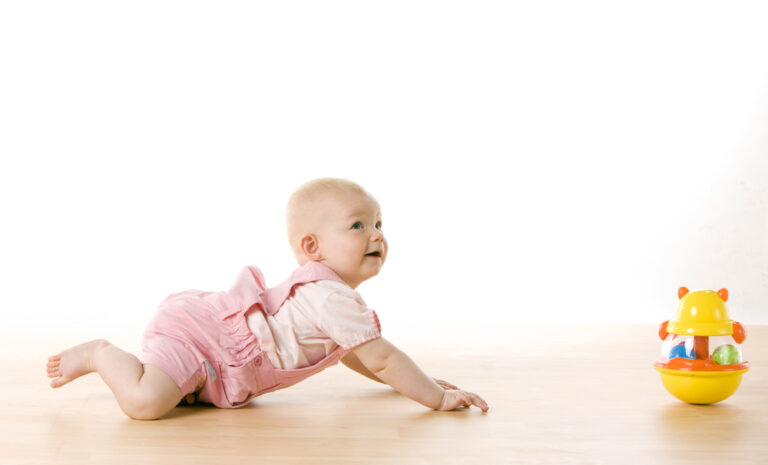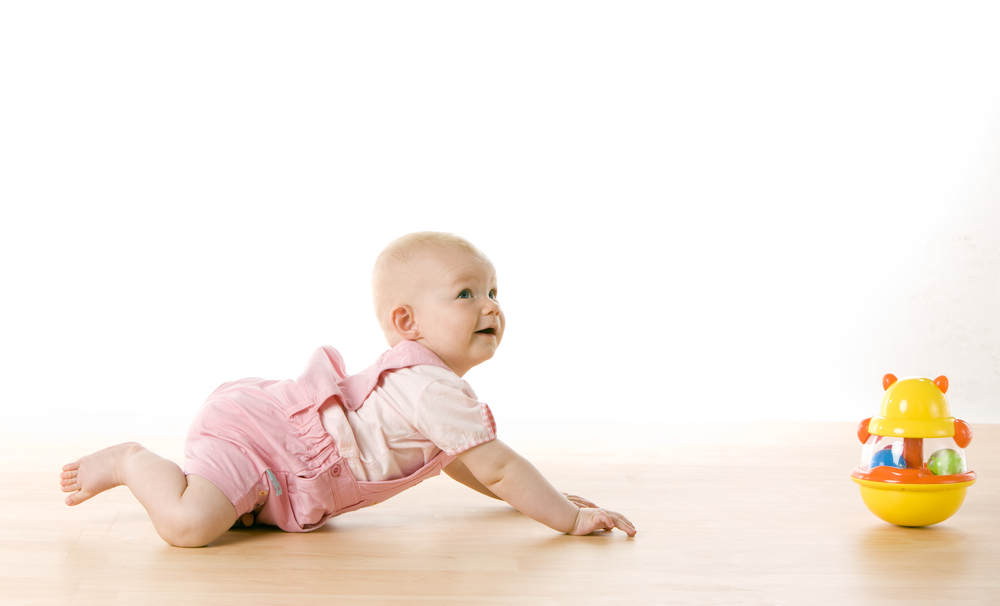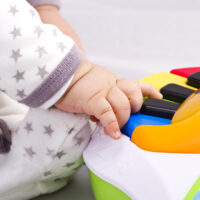Most babies start crawling between 6 and 9 months old. For some babies, it may take a bit longer to get the hang of it.
My oldest daughter didn’t learn how to crawl until after her first birthday. Here are some tips from experts that I wish I had known about how to help baby learn to crawl.
How Can You Help Your Baby Learn to Crawl?
1. Start With Supervised Tummy Time
The first step in helping your baby with the skills needed for crawling is to give her plenty of awake and supervised tummy time from soon after birth. Remember, babies need to be on their backs to sleep.
This is where we didn’t do so well with our oldest. She hated being on her tummy when we tried even as a very new baby. Instead of persevering, we just stopped putting her on her stomach very much.
The time babies spend on their tummies helps them develop muscles in their necks, shoulders, arms, and torso that will help them get onto all fours later on. They get to be aware of their body in different ways as well. They also get used to seeing the world from a different angle than when they are sitting or laying on their backs.
A fun way to encourage tummy time is to use an interesting play mat or baby gym to lay your baby on. You are sure to find an option you and your baby will both like using in our list of best play mats.
If your baby isn’t super interested in tummy time, like my daughter, you may need to get creative to encourage them. Maybe you can read your baby a book while he or she plays. Many of our best books for 1-year-olds would be great for infants, too.
2. But Don’t Neglect Baby’s Other Sides
As important as tummy time is, your baby will also need play time on their back and even their sides. Being in different positions gives them other ways to strengthen their muscles and become aware of their body parts and positions.
I am not sure I ever thought about putting my kids on their sides to play as babies, though I think the back position comes pretty naturally. Being intentional about laying them down on their left and right sides sometimes would have been beneficial.
3. Encourage Sitting Up Unassisted
Next, as your baby nears the six-month mark, give them more chances to practice sitting up without help. Be sure you stay nearby in case of tumbles.
Sitting up without being in a swing, bouncer, or high chair helps strengthen the muscles in your baby’s torso, which will also help when they attempt to crawl. Being able to get from a seated position to all fours and vice versa is also an important step in body awareness and pre-crawling skills.
I know it is easy to use restraining devices to keep your baby entertained or give you a few minutes to accomplish a task, but try to limit swing, walker, and bouncer time to encourage baby’s own movement.
I think we did do this well with my oldest. We propped her up to sit in a nursing pillow often once she was a few months old, and around six months, she could mostly sit up on her own.
4. Place Toys Just Out of Reach
After your child can sit unassisted or push up on his hands from his stomach, try placing a new or favorite toy just out of reach. This may give your baby motivation to stretch and try new movements to reach the prize.
Besides placing toys directly in front of your child, also try placing them a bit to the side. Figuring out how to pivot is an important pre-crawling skill as well. You could even make a circle of toys around your baby to see how far they will turn to look at them and try to reach them.
If you need toy ideas, check out our best gifts for 1-year-old boys and best gifts for 1-year-old girls for some ideas that may also be appropriate for infants. Some of the best crib toys also could be used for floor play.
5. Use a Tunnel or Mirror
Giving your child a tunnel (or large box) to crawl through can also be great motivation to get moving as they get close to crawling. You may want to place a toy just inside or at the end of the tunnel to sweeten the deal.
Also, placing a mirror near where your baby is playing may encourage them to try to get closer. Babies usually love seeing other babies.
I did not think of these tips when my kids were infants. There was a small mirror on the play mat that they all did like to look in, but it wasn’t big enough to catch their attention from across the room. These ideas may have helped in my house.
6. Try a New Surface
Sometimes it helps to let your baby experiment with moving on a floor that’s a bit slippery. It takes a little less work to get going when the friction is lower, so he may have more success on a wooden floor than a carpeted one in the early stages.
Outdoors may also be a good place to practice. It gives baby a change of scenery, new surfaces to explore, and new destinations to chase down. Just make sure to watch your infant very closely as there may be more hazards outside.
Besides changing the horizontal surface to practice on, you can also give your baby a slightly elevated surface to put her hands up on. Putting a crib mattress or couch cushion nearby with a toy on top can encourage your little one to figure out how to push his body up.
That change in elevation with the hands is a skill that will help crawling and pulling to standing. As your baby’s arms and core get stronger and he face plants far less, you can use taller and firmer surfaces (maybe an upside down toy bin). Just make sure the elevated surface is stable so it won’t topple when pushed on.
7. Provide a Pushing-off Place
If your baby can get up onto hands and knees but doesn’t know how to move from there, he might need a stable place to push against with his feet. Try placing your hands right behind his feet, pushing them slightly.
He may be able to push against your hands and get his knees moving along the floor. From there, it may not take long for him to get the hang of it and not need your help to get started.
8. Celebrate Progress
Even when your baby hasn’t reached the goal of crawling, you can encourage success by showing your pride in her current achievements. Babies do catch on to the emotions of those around them, so if you are positive about their attempts to move and explore, they may be more willing to try.
On the other hand, if you seem frustrated and disappointed at your baby’s skills, you may discourage her and turn play time into work.
9. Be Patient
Finally, don’t force things. You could be doing everything right to encourage your baby to crawl, and they might just not be ready! Don’t push your child to perform a skill they aren’t ready for.
Keep providing supervised time for your baby to move freely and encourage movement in play. Your baby will find her own method of moving when she’s ready.
As I said earlier, my oldest daughter was a fairly late crawler. But she was an early walker, perhaps because she didn’t have another way to get around. While I would try more ideas to encourage crawling if I was in that situation again, I am glad we didn’t get stressed about it.
I used information from MamaOT.com, WhatToExpect.com, and ZerotoThree.org to confirm the ideas I’ve collected from experience and to learn more expert tips to share here.
FAQs for How to Help Baby Crawl
How do I keep a crawling baby safe?
Congratulations! Your baby has now learned to crawl. Your prize? Getting to baby-proof your entire house!
It’s not a fun job, but it is important to keep the rooms that baby will use safe once he or she mobile. That includes removing hazardous objects, restricting access to non-safe items and space, and securing heavy items.
Even with excellent baby-proofing, there’s no substitute for close supervision. Some small children are great at figuring out the gadgets meant to keep them safe.
First, identify which rooms you want your baby to be able to explore and which will remain adults-only. Restrict access to off-limits areas with gates or doorknob locks. If you have need of an easily retractable gate, we have a list of the best retractable baby gates.
Next, make sure poisons (medicine, household cleaners, etc) and sharp objects are on a high shelf, preferably in an adult-only space. Look for small items that could be choking hazards that would be in baby’s reach and remove them. Also, remove breakable or irreplaceable objects from family spaces.
After that, look for outlets within reach and cover unused ones. If you have blinds, check that any cords are out of reach so your baby isn’t caught and strangled in them.
Another step is to examine your furniture and other heavy items in the family spaces. Are there sharp corners your baby could fall on? They might need padding. Are there furniture items, like bookshelves or dressers, that could tip if they were climbed? These can be tethered to the wall.
Kitchens and bathrooms have many hazards, so pay special attention to them if you can’t keep baby out. Check what is in your lower cabinets and rearrange them or get cabinet locks. Keep knives away from the edges of counters and keep pot handles turned inward on the stove. Keep hazardous chemicals up high and locked away in the bathroom and look into a toilet lock.
This is just an overview of baby-proofing. Check out more expert ideas on making your home safe for baby.
Don’t forget to keep baby safe, too! Crawling itself can also be hard on your baby’s knees. If your little one is constantly scraping or bruising her knees while crawling, consider our favorite knee pads for crawlers.
When does a baby learn how to crawl?
Many babies learn to crawl between six months and a year of age, with most learning at nine months or later, according to WhattoExpect.com.
There are a variety of ways babies crawl, not just the classic hands and knees motion you may be picturing. Some army crawl on their stomachs, some scoot backwards. Some use only one leg, and some use their hands and feet rather than knees.
My youngest daughter moved around sitting up with one leg tucked under her for awhile, which was funny to watch. My middle did the army crawl for a bit before figuring out the hands and knees crawl.
Any method of crawling is fine developmentally. In fact, skipping the crawling stage altogether is not necessarily a cause for concern. Some babies, like my oldest, just aren’t interested.
Should I be concerned about my child not crawling?
Probably not. If your child doesn’t seem behind in any other areas, they are probably developing just fine. Keep encouraging them to move and strengthen their muscles, but don’t stress about it.
If your baby can’t move both sides of her body equally well, that would be a cause for concern. Make sure you bring up that or any other issue that worries you with your child’s doctor.
My oldest daughter has progressed very well since she basically missed the crawling milestone. She was an early walker and hit all her other toddler milestones on time or early. She is a gifted elementary student now, years later.
What other milestones should my baby be reaching?
According to WebMD.com, there are many skills babies 7 to 12 months old will be working on. Around 7 to 9 months, babies may start sitting unassisted, respond to often-used words, and be able to clap.
Between 10 and 12 months, many babies practice picking up small objects, like cereal pieces, and can feed themselves. They also may walk holding onto furniture, say a couple of words, and begin to be able to pretend play.
These are very general timelines, though. If your baby is continuing to learn new skills, he is probably developing at the right pace for him.
But if you have any concerns, it is good to bring them up to baby’s doctor early on. The doctor will be able to reassure you if everything is normal. But if there is a true developmental delay, early intervention can be very helpful.
Final Word
Crawling is an exciting milestone in your baby’s development, but not a very crucial one for normal development.
All of the tips here on how to help baby learn to crawl also set your child up for success in other areas of movement. So continue to place baby on all sides of her body for play, use new toys and surfaces to keep things interesting, and give her supervised time to explore.
Baby is learning all the time, and these pre-crawling skills are part of the journey.







